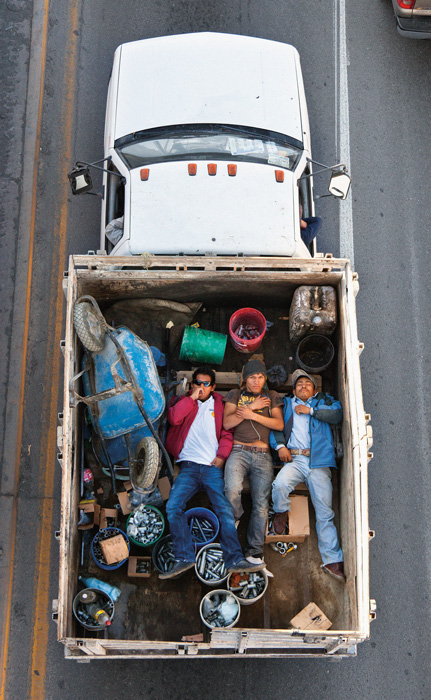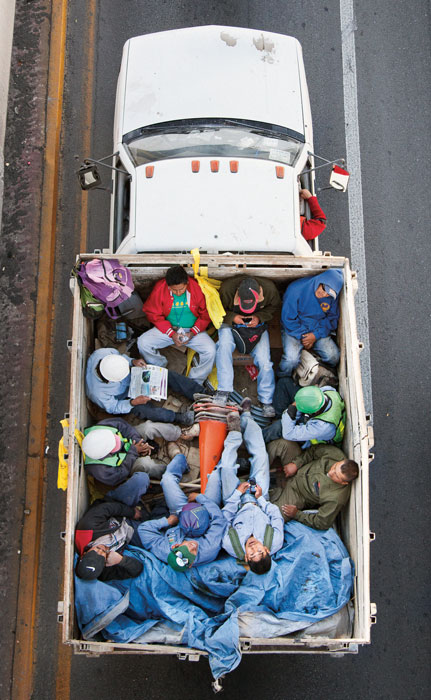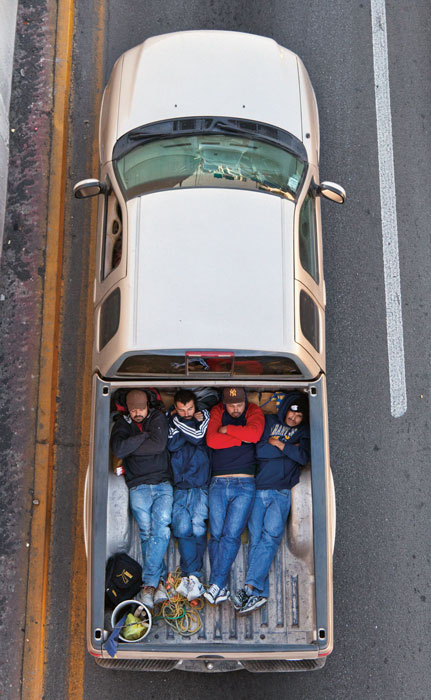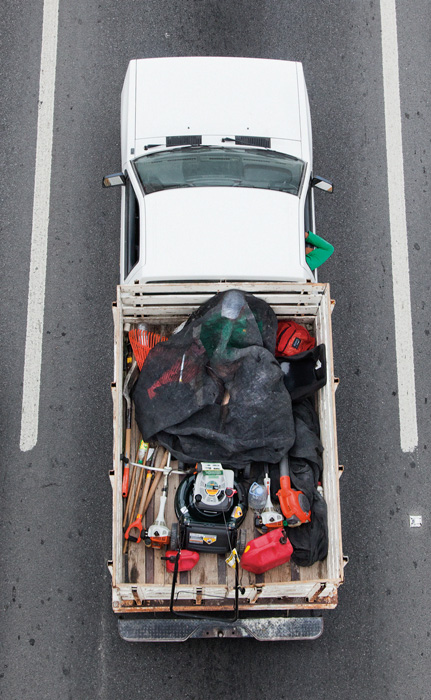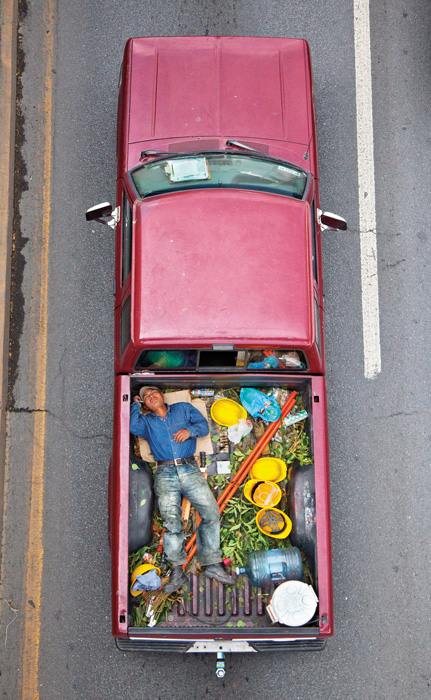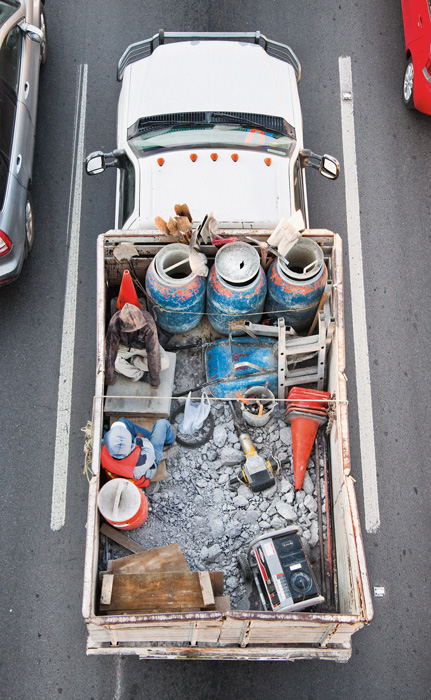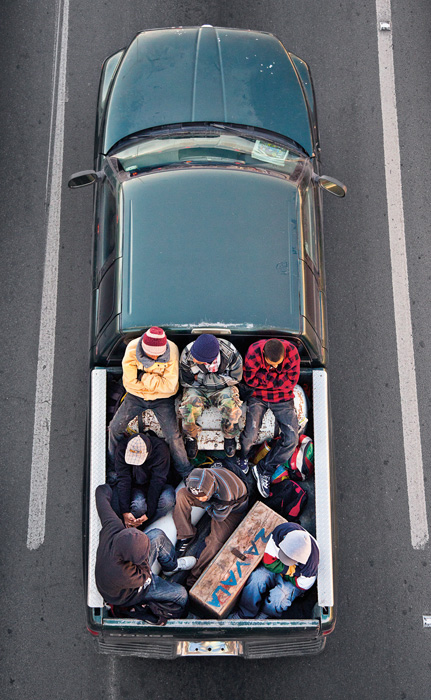In the storybook that is Alejandro Cartagena’s oeuvre, Carpoolers is the chapter that comes between Suburbia Mexicana and What We Fight For. The artist, who works and lives in Monterrey, Mexico, but is originally from the Dominican Republic, has been researching and imaging urban sprawl and its impact for the last decade in photographs that mix a luscious kind of composed beauty with deep human interest. Carpoolers captures part of the everyday that is hidden from most people – the to and fro of a mass of workers from the blue-collar suburb that they live in to the moneyed suburb that they work in. Shot on the fly from atop an overpass as traffic zoomed by beneath him, Carpoolers was the first project in a long time for which Cartagena used a digital camera, as he usually chooses to work with large-format cameras for landscapes and portraiture. This project required a different kind of strategy.
Can you start by describing the physical process of taking the Carpoolers photographs?
The pictures were taken from a pedestrian overpass over- looking Highway 85, just above a spot where cars come out of an underground tunnel. My thinking was that when I spotted them, if the cab of the truck was filled with guys, chances were that there would be more in the back. I was set up over the middle lane of three, so that gave me just enough time to leap into position and try to catch them.
So you would look on one side of the overpass to spot the vehicles from the front and then run and point your camera downward from the other side to shoot?
Yes, and then just wait for the truck to come into frame. I played a game with myself: I wanted to be the one doing the actual work rather than the camera, so instead of using the automated shutter function that professional cameras have, where you just press the button and it shoots five or six shots per second, I did it manually and shot only one or two. If I got it I got it, and if not, too bad. And of course my success rate was only 30 percent, because the trucks are going anywhere from sixty to a hundred kilometres an hour. I do most of my projects with a large-format camera, a plate camera on a tripod that produces a single image, which I look at for ages under a black cloth, examining the light, focusing, framing – it’s a really slow process. So here I wanted that feeling of really making a decision.
This overpass, is it around Monterrey, where you live?
Yes, it’s located over a highway that runs from the northern suburb to the southern suburb of Monterrey. This is where the project got really interesting for me. For the Suburbia Mexicana project, I had photographed the northern suburb, which is the blue-collar suburb that was built at the end of the last decade. And then I had photographed the southern suburb, which is a city called San Pedro, one of the richest cities in Latin America. I’m interested in the relationship of interdependence between the two, and here were these pickup trucks exemplifying the connection. This is how these guys buy their houses, by keeping up the houses of the rich. And this is how they travel, because the northern suburbs grew so fast and so chaotically that there’s no public transportation for them to actually get to work.
Is there a difference in how you approach series like this, in which there’s a great distance between you and your subjects, and others that feature more intimate portraiture?
I’m not interested in old-style photography in which the person has to have a story and the magic of the image is in the story that you can tell. I don’t really ask the names of people whom I photograph, even when they’re in front of me, because for me they’re just a part of the bigger picture. They’re characters, and we don’t need exact names to see that they’re struggling with heavy shopping bags because there’s no public transportation and they can’t take a taxi because it’s too expensive, or that they’re digging a hole in front of their house to build a wall because there’s no police in the suburbs. It’s about filling a gap in this massive story that I’m trying to construct about how the suburbs were built in Mexico.
In much of your work you build real chronological narratives, with many interstitial images and moments of quiet that serve practically as paragraph breaks.
That’s what interests me, it’s more those gaps – those suggested ideas that aren’t there, but that you can read if you’re interested. And there’s always the visual impact, of course; I love beautiful photographs, I love beautiful paintings, I love beauty – but it’s one of many layers that I wish my images to convey. The work wouldn’t be as interesting for me if it was just chance encounters, if I’d just photographed these guys going to work without this connection of already having photographed not only where they’re going to work, but where they live themselves.
Have you found that one topic leads to another, in your work? Is your process sequential, or do you work on many bodies of work at the same time?
I do both. I’ve been invested in this project about the city and how it grows for about ten years now. Suburbia Mexicana, Carpoolers, Overgrowth, What We Fight For – all these projects are intertwined because of the research I’ve been doing. It makes the work really honest, I feel, because it’s something that I’m empirically gaining knowledge on, I’m physically going to the spaces, I’m photographing, looking, asking questions – plus I’m doing theoretical research in urbanism and social theory. So it would a shame to waste all that and move on.
Do you feel that there’s an investigatory aspect to your process, in that you’re hunting down stories that reveal a wider social issue that people might not see otherwise?
Yes. And to me, that’s where the poetry lies, if I can call it that. You have pictures of guys travelling to work, and pictures of little houses in the middle of nowhere, and suddenly you get that those guys live in those houses. And that little spark of visual connection brings out knowledge, or poetry.
When did your work transition from more psychological themes to more social ones? I’m thinking of your early self-portraits, or the series Dulces Intentiones.
When I got into photography, I was in a very psychological, interior place, in which I was coming to peace with this idea of letting go of what I had done up to then. I was in the service industry for fifteen years before getting into photography at the age of twenty-seven. I felt I was late in the game, and the first thing you explore as an artist is yourself, so I worked through that process really fast, then started to look outward to what was happening around me. I wasn’t born in Monterrey; I was born in the Dominican Republic and then brought to Monterrey when I was thirteen, so something that always interested me in being a foreigner was, who are the people that are around me? Because if I know who they are, I’ll know who I’m becoming. And then this idea of this space that’s around me, that’s pushing me to become a certain person because of how the city is built, how the streets are formed – all these things help construct my new identity.
How did you take on the identity of a photographer?
Well, you know, for the first five years I was lucky enough not to go to photography school, but to find work as a digitizer for a photography archive. My work was to digitize thirty to fifty plate negatives a day from the nineteenth and twentieth centuries, and I did that for five years. I learned how to photograph in my head through the work of other photographers. I learned how to print their work and how to frame their work, how to construct an exhibition, how to write about the work – I mean, it was really like a five-year master’s program on how to be a photographer. And the income from that job allowed me to pursue my own work. Every little cent I had was poured into making prints, buying film, developing film, and just making things as fast and as deep as I could.
And since, you’ve been so prolific! What’s the secret of your work ethic?
It’s a cultural thing – my parents were workaholics, my grandparents were workaholics, and I’m married to a workaholic. We have two kids, and I was scared when we started our family that I wouldn’t be working so much, so I worked more! In the last three years, since we’ve become parents, I’ve done almost the same amount of work as in the seven years previous. If you come to my studio today, there’s one, two, three, four, five . . . six projects on the wall, which I’m in the process of doing and editing. I just love working. This phenomenon of people paying you for expressing what you think is amazing. It’s the best job ever.
Isa Tousignant is a contributing editor at Canadian Art and a freelance writer on art, design, and lifestyle who cut her teeth as arts editor at an alternative weekly. She has dabbled in independent curating and helped to create a number of art happenings. Her postgraduate research on animals in contemporary art and inter-species power dynamics has led her to become a born-again vegan. She lives and works in Montreal.
Alejandro Cartagena uses landscape and portraiture as a means for examining social, urban, and environmental issues. His images, featured in exhibitions, photobooks, and news reports, have received many awards, are in the collections of major museums in the U.S., Mexico, and Brazil, and have been published in the most important European and American newspapers and magazines. The Carpoolers project also exists as a very interesting photobook which can be viewed at: vimeo.com/110235644.
www.alejandrocartagena.com
Purchase this article

